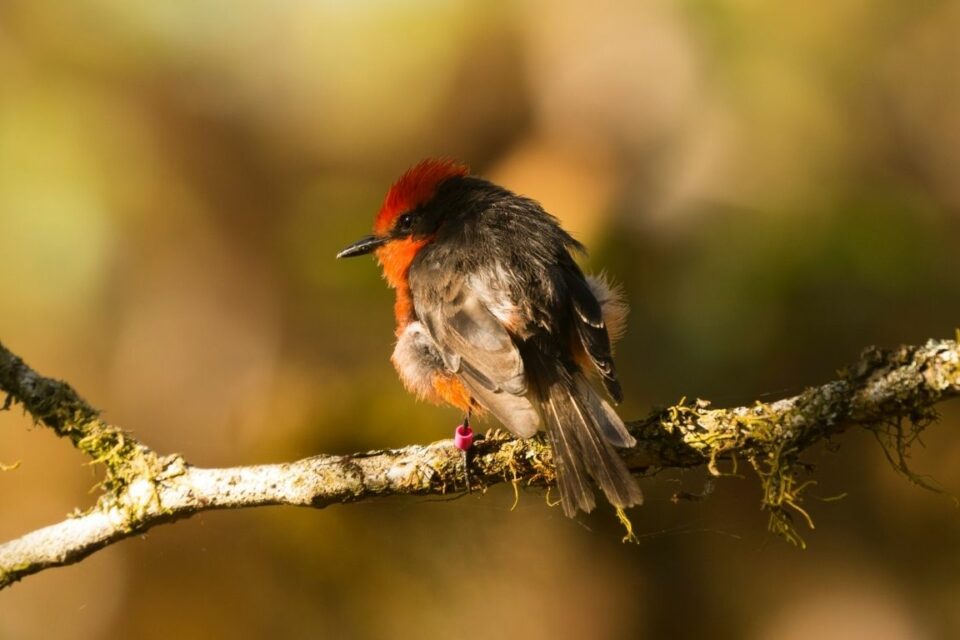

Overview
In 2012, Pinzon island was cleared of invasive rats after many of its native species became locally extinct, including the woodpecker finch. Ten years later, there are promising signs of ecological recovery, and GCT is supporting our partners to deliver surveys to track this, as well as efforts to re-establish a breeding population of woodpecker finches. Learnings from this will be vital for supporting reintroduction plans for songbirds on Floreana island and conservation plans for the Critically Endangered mangrove finch.
Project Partners






Pinzon in numbers

> 10
years since the eradication of invasive rodents

2
endemic bird species have naturally colonised Pinzon

23
woodpecker finches were reintroduced to Pinzon in 2022

The problem
Like many other islands in Galapagos, black rats were accidentally introduced to Pinzon island in the late 19th century, becoming an invasive species. Predation by rats devastated the island’s ecosystem, partly due to the severe decline in successful reproduction of birds and reptiles, with eggs providing an easy meal for the rats. This includes the near local extinction of Pinzon’s giant tortoise population – there were only around 100 adult tortoises left in the wild in the 1960s.
However, we are now looking at a conservation success story unfolding before our eyes. In 2012, removal of invasive rodents with poison bait successfully rid the island of their presence. In 2015, it was confirmed that Pinzon giant tortoises are reproducing in the wild again – a conservation win that was supported by a decades-long captive breeding programme led by the Galapagos National Park. Two native bird species in Galapagos have also naturally colonised the island – the Galapagos rail, which had never been previously recorded on Pinzon, and the cactus finch, a species considered locally extinct on Pinzon for more than 40 years. The island’s biodiversity is rebounding and conditions are now right for reintroductions of other locally extinct species to support its ecological recovery.

How we’re tackling it
In June 2022, we began supporting the Galapagos National Park and Island Conservation with the first ever inter-island translocation of woodpecker finches to Pinzon. Birds were captured, tagged and banded from a large, healthy population on Santa Cruz island, with captive holding plans for the finches informed by finch holding trials delivered on Floreana island in 2019-2020. In June, 11 birds were released on Pinzon and a further 12 birds were released in July. We continue to support post-release monitoring of the birds, including monitoring whether the birds attempt to fly home, helping to determine whether translocation of more woodpecker finches should go ahead and if any methods need adjusting.
These surveys have been done in combination with surveys to monitor biodiversity recovery on the island, including during a survey marking the ten-year anniversary of the rodent eradication on Pinzon. During field work for these surveys, local specialists have been trained in the techniques and methods of songbird capture, captive holding, release and monitoring, paving the way for the future reintroductions to be supported by local teams.
The learnings from these activities will not only be vital for continuing to restore Pinzon’s ecosystem, but helping to inform plans for the restoration of Floreana island, including species reintroductions, where an eradication is planned for October 2023.

Project goals
- Track biodiversity recovery on Pinzon over time
- Evaluate the reintroduction of woodpecker finches on Pinzon island
- Apply learnings to potential future reintroductions on Pinzon and for other Galapagos songbirds within the Archipelago including Endangered and Critically Endangered species.
Project updates


Galapagos Day 2022: Protecting Species & Preventing Extinctions

Protecting the Birds of Galapagos webinar 2022

Invasive pigs in Galapagos
How you can help
By supporting Galapagos Conservation Trust you are making a vital contribution towards safeguarding the future of these Enchanted Isles and their unique wildlife.





